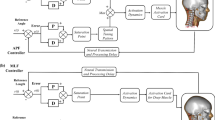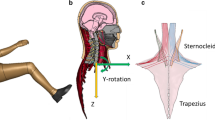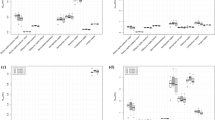Abstract.
We present a controls systems model of horizontal-plane head movements during perturbations of the trunk, which for the first time interfaces a model of the human head with neural feedback controllers representing the vestibulocollic (VCR) and the cervicocollic (CCR) reflexes. This model is homeomorphic such that model structure and parameters are drawn directly from anthropomorphic, biomechanical and physiological studies. Using control theory we analyzed the system model in the time and frequency domains, simulating neck movement responses to input perturbations of the trunk. Without reflex control, the head and neck system produced a second-order underdamped response with a 5.2 dB resonant peak at 2.1 Hz. Adding the CCR component to the system dampened the response by approximately 7%. Adding the VCR component dampened head oscillations by 75%. The VCR also improved low-frequency compensation by increasing the gain and phase lag, creating a phase minimum at 0.1 Hz and a phase peak at 1.1 Hz. Combining all three components (mechanics, VCR and CCR) linearly in the head and neck system reduced the amplitude of the resonant peak to 1.1 dB and increased the resonant frequency to 2.9 Hz. The closed loop results closely fit human data, and explain quantitatively the characteristic phase peak often observed.
Similar content being viewed by others
Author information
Authors and Affiliations
Additional information
Received: 15 April 1996 / Accepted in revised form: 1 July 1996
Rights and permissions
About this article
Cite this article
Peng, G., Hain, T. & Peterson, B. A dynamical model for reflex activated head movements in the horizontal plane. Biol Cybern 75, 309–319 (1996). https://doi.org/10.1007/s004220050297
Issue Date:
DOI: https://doi.org/10.1007/s004220050297




